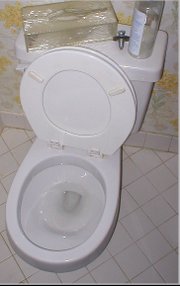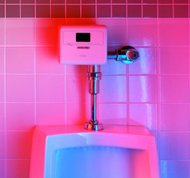Flush toilet

A flush toilet or water closet (WC) is a toilet that disposes of the waste products by using water to sweep them away down a drainpipe. The water is also used as a hygienic barrier between the drainpipe and the user.
Invention timeline
As with many inventions, the flush toilet did not suddenly spring into existence, but was the result of a long chain of minor improvements. Therefore, instead of a single name and date, there follows a list of significant contributors to the history of the device.
Note: due to the lack of information from other cultures, this chronology is regrettably Anglocentric. Additional information about early flush toilet technology in other parts of the world would be welcome.
- Ancient world: there are remains of flushing toilets, both domestic and communal, from many ancient civilisations around the world, too numerous to list here, dating from 2500 BC onwards. With the fall of the Roman empire, the technology was lost.
- 1596: Sir John Harington is said to have invented 'The Ajax', a flush toilet, for Elizabeth I of England. His design was ridiculed in England, but was adopted in France under the name Angrez. The design had a flush valve to let water out of the tank, and a wash-down design to empty the bowl.
- 1738: A valve-type flush toilet was invented by JF Brondel.
- 1775: Alexander Cummings invented the S-trap (British patent no. 814?), still used today, that used standing water to seal the outlet of the bowl, preventing the escape of foul air from the sewer. His design had a sliding valve in the bowl outlet above the trap.
- 1777: Samuel Prosser invented and patented the 'plunger closet'.
- 1778: Joseph Bramah invented a hinged valve or 'crank valve' that sealed the bottom of the bowl, and a float valve system for the flush tank. His design was used mainly on boats.
- 1819: Albert Giblin received British patent 4990 for the "Silent Valveless Water Waste Preventer", a siphon discharge system.
- 1852: J. G. Jennings invented a wash-out design with a shallow pan emptying into an S-trap.
- 1857: the first American patent for a toilet, the 'plunger closet', was granted.
- 1880s: Thomas Crapper's plumbing company built flush toilets of Giblin's design. After the company received a royal warrant, Crapper's name became synonymous with flush toilets. Although not the original inventor, Crapper popularised the siphon system for emptying the tank, replacing the earlier floating valve system which was prone to leaks. Some of Crapper's designs were made by Thomas Twyford. The similarity between Crapper's name and the much older word crap is merely a coincidence.
- 1885: Thomas Twyford built the first one-piece china toilet using the flush-out siphon design by J. G. Jennings.
- 1886: an early jet flush toilet was manufactured by the Beaufort Works in Chelsea, England.
The bowl siphon
The bowl of a flush toilet is a porcelain vessel with a built-in siphon, usually visible as a curved pipe protruding from the back. Normally, the bowl contains a small amount of water which is enough to form an air trap inside the siphon pipe, preventing foul air escaping from the sewer. When the toilet is used, liquid flows slowly through the siphon pipe as waste matter is added, but the flow volume is too small to fill the siphon. To flush the toilet, the user activates a flushing mechanism (see below) which pours a large quantity of water quickly into the bowl. This creates a flow large enough to fill the siphon tube, causing the bowl to empty rapidly due to the weight of liquid in the tube. The flow stops when the liquid level in the bowl drops below the first bend of the siphon, allowing air to enter which breaks the column of liquid.
Flushing mechanisms

The bowl siphon described above is triggered by a large flow of water into the bowl, which is provided by the flushing mechanism. This is usually of one of the following designs:
Direct flush (flushometer)
In the old-style manual flush systems, the user presses a button, which opens a valve allowing mains-pressure water to flow into the bowl, or sometimes the user presses directly on a flush lever (a handle connected directly to a flushometer). The valve contains a pneumatic mechanism that closes it after a preset time. This system requires no storage tank, but requires high volume water for a very brief time period. Thus a 3/4 inch (19 mm) pipe at minumum, and preferably a 1 inch (25 mm) pipe, but the high volume is used only for a short duration so very little water is used for the amount of flushing efficacy delivered. Direct valves are regulated by a device called a "flushometer" that meters out a certain controlled amount of water per flush. Direct flush makes the most efficient use of water, because it uses the water at full pressure and volume. The ability of water to perform the work in removing waste matter from the toilet bowl is given by pressure times volume. Typical pressure in an urban commercial building where flushometers are usually used is around 60 pounds per square inch (400 kPa) which is enough pressure to raise the water 137 feet (42 m) above the toilet bowl. Thus, in some sense, the effectiveness of Direct flush is like having the tank 137 feet (42 m) above the bowl (lots of "flush energy").
Tank-type
A storage tank collects between 6 and 9 litres of water over a period of time. This system is suitable for locations plumbed with smaller diameter pipes. The storage tank is kept full by a float valve or ball cock. An outlet in the bottom of the tank is covered by a buoyant plastic cover (the flush valve) which is held in place by water pressure. To flush the toilet, the user pushes a lever, which lifts the flush valve from the outlet. The valve then floats clear of the outlet, allowing the tank to empty quickly into the bowl. As the water level drops, the floating flush valve descends back to the bottom of the tank and covers the outlet pipe again. This system is common in the USA. Tank type toilets waste the energy in the water by converting the potential energy of 137 feet (42 m) (the "head" of pressure in typical city watermains) times acceleration due to gravity, into around 18 inches (460 mm) above the bowl. Some older style toilets mitigate this waste of energy to some degree by having the tank be as high as possible (up near the bathroom ceiling), but modern tank type toilets waste the energy in the water, and therefore either use more water than necessary for a given flushing job, or for the same amount of water, flush less effectively than direct flush.
Siphon
This system, invented by Albert Giblin and common in the UK, uses a storage tank similar to that used in the flush valve system above. The user pushes a lever or button, forcing the water into a siphon (not to be confused with the bowl siphon) which empties the entire tank into the bowl. The advantage of a siphon over the flush valve is that is has no sealing washers that can wear out and cause leaks, so it is favoured in places where there is a need to conserve water. Until recently the use of siphon-type cisterns was mandatory in the UK to avoid the potential waste of water by millions of leaking toilets. Older installations used a high-level cistern, fitted above head height, that was operated by pulling a chain hanging down from a lever attached to the cistern. Modern versions have a low-level cistern with a lever that the user can reach directly, or a 'close-coupled' cistern that is even lower down and integrated with the bowl. This lower level results in loss of potential energy in the water, as the potential energy of water pressure is converted to the potential energy of height in a less advantagous manner, due to very little height, as described above.
Pressure assist
Not uncommon in the United States, this system [invented by Bruce Martin] uses the water pressure within a structure to compress air within a closed vessel located within the vitreous enclosure. When flushed, the compressed air pushes into the bowl at a velocity [GPM flow rate] significantly higher than gravity flow. This system is more water efficient than a tank type and can be installed into the same fittings as the latter. However it costs 10% less than the new 3" gravity flapper equipped tank-type toilets. Pressure assist toilets are used in both private [single and multiple and lodging] bathrooms as well as light commercial installations [offices, etc.] They hardly ever clog and so require less maintenance.
Automatic flush
"Automatic flush" refers to a triggering mechanism, rather than a water propulsion mechanism, although is usually implemented together with direct flush systems. Autoflush systems, as the name suggests, flush automatically once the user has left. Typically, an override button is provided if the user wishes to trigger flushing earlier. In retrofit installations a flushometer can be replaced with a self-contained battery operated machine vision system that actuates a solenoid when a user departs. There are two main kinds of machine vision systems used for sensor operated flush: passive; and active. Passive systems such as Passive InfraRed (PIR) see the body of the user by electromagnetic energy that is received by the sensor. Active vision systems provide a source of electromagnetic energy (radar, infrared, or the like) and see reflected energy from the target (e.g. the user of the fixture).
Manual operation
If the flush mechanism should fail in any of these systems, the bowl siphon can be activated by emptying a large bucket of water into the bowl. A domestic hose pipe will not work, as it cannot supply water fast enough to fill the siphon tube. A larger hose, or small firehose, even a 3/4 inch (19 mm) Garden Hose Thread (GHT) firehose, provides sufficient water to flush without a bucket.
See also
External link
- Intelligent Bathroom Fixtures and Systems (comparison between passive and active vision systems for use with plumbing fixtures, as published in Leonardo, 36(3), pp 199–120, June 2003).
